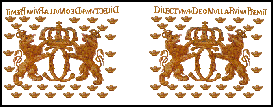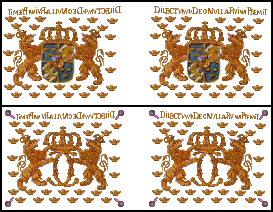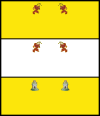|
Swedish Infantry Colour Sheets

Livgardet's m/1686 colour
This page contains a collection
of colour sheets intended to be used for Prince August's miniature figures
(40 mm scale). These are free to be used by everyone, just click on the images
and then print out the sheets.
Guard Colours
The Guard (Livgardet) was an
enlisted regiment based in Stockholm which at the outbreak of the Great Northern
War consisted of 1 800 men distributed to 12 companies which had one colour each.
It was then gradually expanded to reach 2 600 men in 24 companies in 1704 (six of
these were however grenadier companies which did not carry colours).
The colour sheet to the left is the
Guard's company colour m/1686. The two colour sheets to the right are my
reconstructions of the Guard's colonel's colour (Swedish coat of arms instead of
the royal cypher) which was carried by the Colonel's Company and the special
grenadier colours which were issued in 1702 but carried until the battle of Poltava
by three regular companies. The grenadier colours were said to have included flaming
grenades in the corners but just like the colonel's colour there are no preserved
image of them.


Provincial Regiments' and Småland 3-männings' colours
A typical Swedish infantry regiment
consisted of 1 200 men in eight companies. Of the provincial regiments it was
only Närke-Värmland which had more than eight companies (1 674 men in ten
companies). Each company had their own colour which had the same appearance as
the other companies in the regiment (except the Colonel's Company) and followed
the regulation of 1686, hence called m/1686 colour. The Colonels Company
distinguished itself by having a white colour featuring the Swedish coat of arms
in the centre and the regimental symbol in the upper inner corner. The regimental
symbol was in most cases the coat of arms of the province in which the regiment
was recruited in. The exceptions were Jönköping and Älvsborg regiments which
instead had the coat of arms of the cities Jönköping and Gothenburg. The regular
companies' colours had the regimental symbol inside a laurel wreath. Some
variations existed when more than one regiment was recruited in the same province
or when the provincial coat of arms had a black or white field.
When the Great Northern War broke out
there was a need for additional regiments. This was done by combining the "rotar"
(responsible for the upkeep of one soldier) in groups of three to recruit an
additional soldier, a so called 3-männing. This meant that an area which maintained
a 1 200 men strong regiment had to recruit a further 400 men which were then
combined with contingents from other regimental districts to create new full size
regiments. These contingents carried colours with their parent regiment's symbol
in the upper inner corner in an otherwise plain colour. An example of this is the
colours of Småland 3-männing Regiment which carried one white (colonel's colour) and
four yellow colours with the red crossbow carrying lion of Småland in the corner and
three yellow colours with the coat of arms of the city of Jönköping.

Uppland
|

Södermanland
|

Östergötland
|

Kalmar
|

Kronoberg
|

Jönköping
|

Älvsborg
|

Västgöta-Dal
|

Skaraborg
|

Närke-Värmland
|

Västmanland
|

Dal-regiment
|

Hälsinge
|

Jämtland
|

Västerbotten
|

Österbotten
|

Björneborg
|

Åbo
|

Nyland
|

Tavastehus
|

Savolax
|

Viborg
|

Småland
3-männings |
Next page
|

